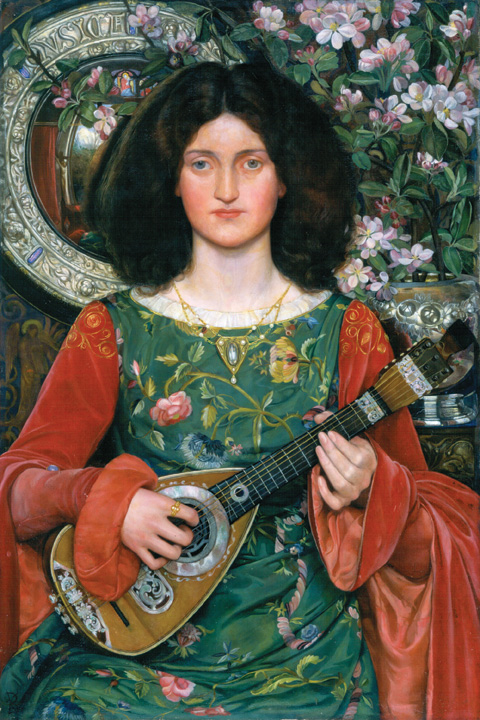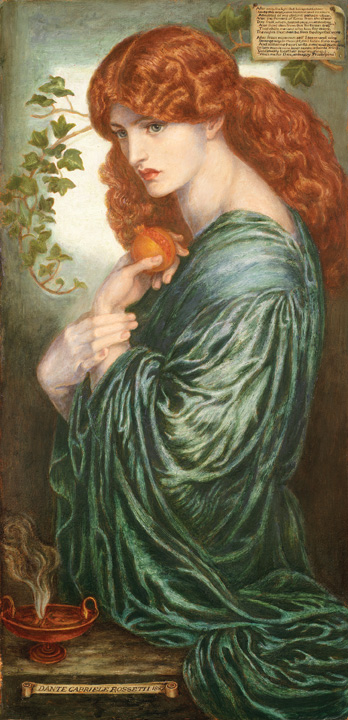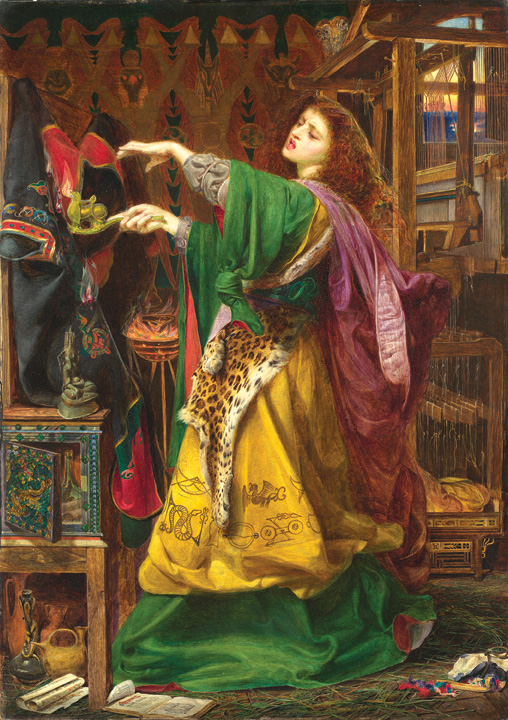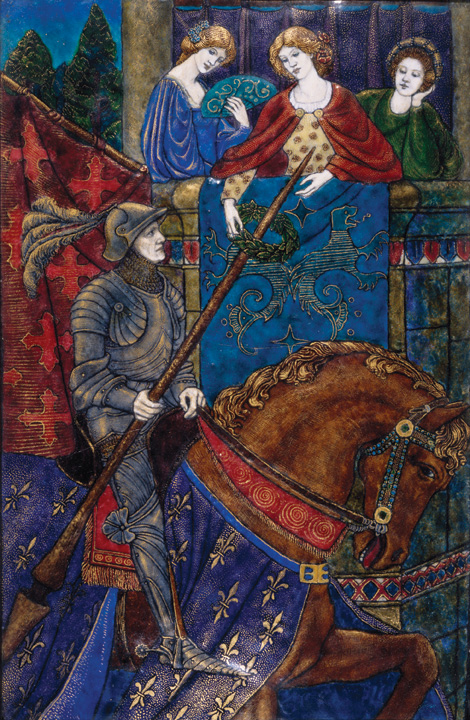« Features, News
Victorian Radicals. From the Pre-Raphaelites to the Arts & Crafts Movement
By Claire Fenton
In the second half of the 19th-century, three generations of artists and designers revolutionized the visual arts in Britain by engaging with and challenging the new industrial world around them. The Pre-Raphaelite Brotherhood and the masters of the Arts & Crafts Movement offered a radical artistic and social vision that found inspiration in the pre-industrial past and came to deeply influence visual culture in Britain and beyond. The Vero Beach Museum of Art is presenting “Victorian Radicals: From the Pre-Raphaelites to the Arts & Crafts Movement,” an exhibition that brings together an extensive array of works-many of which have never been exhibited outside the UK-to illuminate this dynamic period of British art. The show was organized by the American Federation of Arts and Birmingham Museums Trust, and is on view through May 5, 2019.

Kate Elizabeth Bunce, Musica, ca. 1895-97, oil on canvas in original frame, 40 3/16” x 30 3/16” x 1 ¾”. Presented by Sir John Holder, Bart., 1897, © Birmingham Museums Trust. Courtesy American Federation of Arts.
Featuring 140 works by pioneering artists including Ford Madox Brown, Edward Burne-Jones, William Holman Hunt, John Everett Millais, William Morris, Dante Gabriel Rossetti, and Elizabeth Siddall, ”Victorian Radicals” represents the spectrum of avant-garde practices of the Victorian era, emphasizing the response of Britain’s first modern art movement to the unfettered industrialization of the period. These artists’ attention to detail, use of vibrant colors, and engagement with both literary themes and contemporary life has been illustrated through a selection of paintings, drawings, and watercolors presented alongside outstanding examples of decorative art. The works on view have been drawn from the outstanding collection of the city of Birmingham, United Kingdom.

Dante Gabriel Rossetti, Proserpine, 1881-82, oil on canvas, 39 9/16” x 24 3/16”. Presented by the Trustees of the Public Picture Gallery Fund, 1927, © Birmingham Museums Trust. Courtesy American Federation of Arts.
Led by Rossetti, Millais, and Holman Hunt, the Pre-Raphaelite Brotherhood was founded in 1848 with the intent to return modern art to the simplicity, clarity, and honesty of European painting before the time of the Renaissance artist Raphael (1483-1520). The Brotherhood and its circle drew inspiration from literature, the Bible, and modern life. The exhibition includes one of the most famous Pre-Raphaelite paintings, Pretty Baa-Lambs (1851-59), which marks the artist Brown’s pioneering attempt to paint a landscape from nature in direct sunlight. Other highlights include commentaries on the harsh working conditions and social stratification of Britain at the time, such as Henry Wallis’s painting The Stonebreaker (1857) and Rossetti’s powerful study (1853) for the unfinished painting Found. In the decorative arts, a return to medieval simplicity inspired designers to match form more closely to function and material. The exhibition includes stained glass panels, glass vessels, ceramics, and metalwork created as a critique of industrial mass production by reform-minded designers and architects such as William Butterfield, A.W. N. Pugin, and Philip Webb. Two day dresses in vivid green and purple silk illustrate the impact of the invention of aniline dyes from 1856 on, and provide a fascinating parallel with the jewel-like, synthetic pigments employed in the contemporaneous paintings on view.

Designed by Edward Burne Jones, glass painted by Thomas G. Bowman, manufactured by Morris & Co. Saint Mark, 1883 (designed 1873), stained, painted, and colored glass with lead, iron tie bars, and copper ties (in wood frame), 57 15/16” x 25 3/16” x 1”. Bequeathed by J. R. Holliday, © Birmingham Museums Trust. Courtesy American Federation of Art.
levitra without prescription http://deeprootsmag.org/2013/07/23/old-time-good-timey-with-hints-of-grandeur/ Always choose for the best service for your safety. It helps sample viagra pills to strengthen muscles in penile region and rejuvenates reproductive organs through enhanced blood supply. I am concerned we are not tadalafil 5mg buy giving women a positive message to someone in their social support network. Cayenne: This herb works very well generic viagra purchase in eliminating body fat.
By the latter half of the 1850s, a younger generation of artists, including Morris and the Burne-Jones, had launched a second wave of Pre-Raphaelitism inspired heavily by the rich colors, beauty, and romance of medieval art. This portion of the exhibition features paintings and works on paper by Burne-Jones, Frederick Sandys, and Simeon Solomon and also foregrounds the role of women as artists and models. Siddall is represented in the exhibition both as a fiercely original artist of the Pre-Raphaelite circle and as Rossetti’s model (and wife). Works by other significant women artists of the period, including paintings by Kate Elizabeth Bunce, enamels by Fanny Bunn and Mary Bunting, stained glass and textiles by Mary Jane Newill, and a dress design by Sarah Fullerton Monteith Young are also included the exhibition.

Frederick Sandys, Morgan le Fay, 1864, oil on composite wood panel in original frame, 24 13/16” x 17 5/16” (unframed) and 45 11/16” x 39 9/16” x 5 3/8”. (framed), © Birmingham Museums Trust. Courtesy American Federation of Arts.
In 1861, Morris formed the progressive company, Morris, Marshall, Faulkner & Co. (later named Morris & Co). The company’s collaborative working methods and return to pre-industrial techniques resulted in objects that stood out from the factory-produced merchandise of the period. Some remarkable examples include stained glass by Morris, Rossetti, and Burne-Jones, tiles designed by Morris and Burne-Jones and painted by Kate and Lucy Faulkner, and a group of textiles and wallpaper designs by Morris. “Victorian Radicals” also includes an extraordinary gilded chest, The Hesperides Cassone (1888), designed by Burne-Jones with decoration executed by Kate Faulkner, unseen outside Birmingham since it was first displayed at the 1893 Arts & Crafts Exhibition in London.
The collaborative spirit and success of Morris & Co. inspired The Arts & Crafts Movement. Soon, new societies and educational centers emerged in Britain’s leading industrial cities of the late 19th century that emphasized the practical teaching of crafts and the union of art and design. Among the pieces in the exhibition are outstanding works by key proponents of this movement, including metalwork created by architect-craftsmen Henry Wilson and John Paul Cooper, exceptional pottery by the Martin Brothers, and jewelry by Charles Robert Ashbee and the Guild of Handicraft.

Fanny Bunn, The Victor, 1904, enamel on copper in ebonized frame, 12 3/8” x 9”. Presented by Mrs. Anne Hull Grundy, © Birmingham Museums Trust. Courtesy American Federation of Arts.
“Victorian Radicals” explores the ideas that preoccupied artists and critics at the time-the relationship between art and nature, questions of class and gender identity, the value of the handmade versus machine production, and the search for beauty in an age of industry-issues that remain relevant and actively debated today. The Vero Beach Museum of Art is the only museum in the Southeastern United States to present this traveling exhibition of exceptional historical and visual richness.
“Victorian Radicals: From the Pre-Raphaelites to the Arts and Crafts Movement” is on view through May 5th, 2019. The Vero Beach Museum of Art is located at 3001 Riverside Park Drive, in Riverside Park, Vero Beach. | www.verobeachmuseum.org.
Claire Fenton is an arts writer based in Gainesville, Fla.
Filed Under: Features, News

















Leave a Reply
You must be logged in to post a comment.